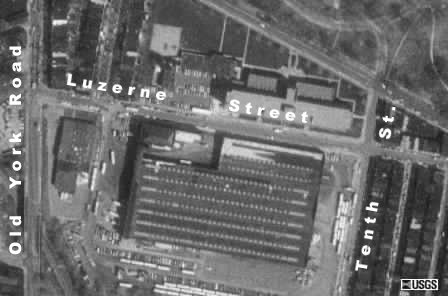Luzerne Depot
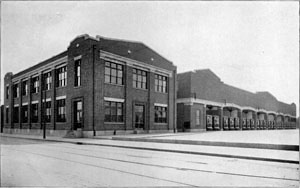
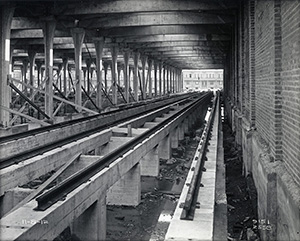
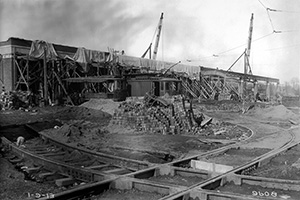



When opened in 1913, Luzerne Depot was the largest precast concrete structure in the world, with space for 355 trolleys, and room for 115 more in the yard alongside.
Built at the same time, Callowhill Depot in West Philadelphia was based on similar blueprints. To read my Hidden City Philadelphia article about Callowhill depot, please follow this link.
In the 1950's, after the National City Lines' takeover of PTC and the scrapping of over a thousand trolleys systemwide, part of Luzerne Depot was converted to a diesel bus garage. Gradually, more and more of Luzerne's ten 3-track bays were converted from rail to buses. Finally in 1992 all rail service was replaced with diesel buses.
In April 1997, Luzerne Depot was closed, completely, despite SEPTA's 1992 promise to re-open the North Philadelphia streetcar system with new trolleys by 1997. Bus operations were moved to the new Midvale District, which was built with zero provision for streetcars.
Luzerne Depot dodged a bullet in 2003. The sprawing facility was very nearly torn down, as this excerpt from the SEPTA web site attests:
"DEMOLITION OF LUZERNE CARHOUSE & TRANSPORTATION
BUILDING
"The scope of work includes the demolition of the Luzerne Carhouse and
Transportation Building, which is approximately a total of 40,000 square feet.
The project site is located at the southeast corner of 1000-1100 West Luzerne
Street, Philadelphia, PA 19140. The work also includes performing all required
demolition and clean-up including removal, disposal, and salvage of existing
at grade and above grade construction within the project boundaries as shown
on the contract drawings."
Update November 2003: Rather than demolition, a deal
was struck that allowed a cardboard re-cycling business to occupy the structure.
1942 PCC 2639 at Luzerne Depot on July 5, 1978. Photo ©
Mike Szilagyi PCC cars 2075 and 2636 lay over on the Route 53 loop. Little Flower Catholic
High School, and the trees of Hunting Park, are across Luzerne Street.
Luzerne Depot as seen from Old York Road, April 1977. Photo
© Mike Szilagyi In this 1977 photo, two of the PCCs acquired third hand from Toronto Transit
Commission await service. Ex-Birmingham Alabama PCC 2311, left, and Ex-Kansas
City PCC 2250 are still in red Toronto Transit Commission paint. Both cars remained
on SEPTA's roster until 1982. July 5, 1978 Photo © Mike Szilagyi July 5, 1978 Photo © Mike Szilagyi In September 1976, Route 23 trolleys were moved from Germantown Depot to
Luzerne Depot, making Luzerne the operating depot for the six remaining North
Philadelphia streetcar routes: 6, 23, 50, 53, 56, and 60. Here is a pamphlet
issued by SEPTA informing the Route 23 operators of this change:
Starting September 5th (1976), Route 23 will return to rail
operation, and be operated out of Luzerne, rather than Germantown Depot. This
pamphlet is designed to help you in the transition to your new location.
Luzerne Depot has 15 bus routes, with 355 bus operators, and 102 rail men who
operate routes 6, 50, 53, and 60. Route 56 is temporarily operated by buses.
The Depot Superintendent is Carl Unruh, and the Assistant is John Pio. They
are there to assist you in any whatever way they can, so stop in and introduce
yourself.
Extra men on Route 23 will also work other Luzerne rail lines starting in September.
Regular Route 23 men will have the opportunity to work other rail lines starting
in January.
Operational Training & Safety
Luzerne's Chief Instructor is Clarence Rowland. He and his instructors are
there to improve our safety record and operator performance, and to help you
whenever possible. Don't hesitate to ask them questions or seek their help.
RS&S
The Luzerne Shop Superintendent is Dave Helfrich and the Rail Foremen are Steve
Stitsworth and Joe Curley. They are anxious to help with any problems you have
connected with the equipment.
When you take a car out of Luzerne and store it, you must do so according to
the following plan.
7 Bay-North, Middle, and South Lines-Route 23
8 Bay-North and Middle-Toronto Cars for Route 60
9 Bay-North and Middle-Bi-Centennial Cars, Route 50
9 Bay-South-Routes 6 and 53
You must follow this plan unless specifically authorized by the Shop Foreman,
an Instructor, or Supervisor, to do otherwise.
The Streetcars
Luzerne operates both electric cars (including ex-Toronto cars, for which you
will be given a pamphlet listing those items that are different from our cars)
and air cars.
Normally, Route 23 will have air cars assigned to it (although electric cars
may be assigned in specific cases). This should help you in your operation and
provide greater reliability on Germantown Avenue's hills.
Air cars are essentially the same in operation as electric cars. Some small
differences that you should be aware of are as follows:
Windshield wipers, sanders, and doors are air operated, instead of electric.
There is also an air operated shoe brake on the tread, instead of the electric
shaft brake. Since the air for this brake can leak off after a time (allowing
the car to roll away), there is also a hand brake that must be set when the
car is stored. The shoe brakes eliminate the need for a brake reset.
These cars have an air gauge on the dash. Safe operation requires that you
have at least 55 pounds of pressure before moving the car.
By the way, RS&S has done a mini-rehab on the cars to be assigned to the Route
23. Graffiti has been removed, seats replaced, and in general, the cars are
more attractive for our passengers. Your assistance in helping to curb vandalism
and graffiti will be greatly appreciated.
Remember...
When another driver does something reckless and you're heading for a collision,
you can't move the streetcar out of the way.
So for safety's sake,
Anticipate.
Pull-Outs and Pull-Ins
South End: West on Luzerne Street, south on Old York Road to Germantown Avenue,
then regular route to Bigler. Pull-In is Germantown to north on Old York Road
to east on Erie, north on 10th Street to depot.
North End: West on Luzerne to south on Old York Road to Germantown, and then
north onto regular route. Pull-In is south on Germantown to east on Tioga to
north on 13th Street to west on Venango to north on Germantown to east on Erie
to north on 10th Street to Depot.
The aerial view at right was taken in March 1992, six months before the last
of the North Philadelphia streetcar lines were converted to diesel bus. By this
time, only two trolley lines operated from Luzerne: routes 23 and 56. And of
those last two routes, diesels buses were often substituted for months at at
time, whenever utility construction occured along those routes. Gone were the
days when temporary tracks were built during construction and contractors were
instructed to work around the streetcars. It was simply easier to suspend trolley
service. Serve the public? "Buses are good enough for 'em."
In this 1992 photo, most of the vehicles visible are buses. The two vehicles
emerging from the shadows at the lower left corner of the building (8- and 9-bay)
appear to be PCC cars.
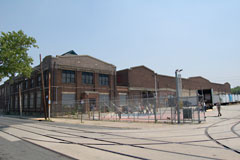
Update June 2007: Follow
this link for photos of Luzerne Depot's current use, including photos taken
inside the former trolley bays.
![]()
Photos of the mothballed PCC fleet that was stored at Luzerne in winter 2001
can be viewed here.
![]()
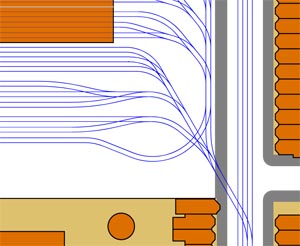 View a track map of Luzerne
Depot showing the track configuration circa 1990.
View a track map of Luzerne
Depot showing the track configuration circa 1990.
![]()
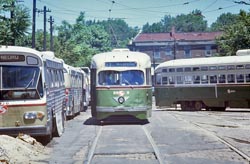 During the 1970s, all that was required for a photographer
to gain permission to gain entry to SEPTA property and take photographs, was
a trip to SEPTA headquarters where a release form could be signed. The release
was valid for that day only, so each trip to Luzerne Depot required a stop at
2nd & Wyoming that day. (With Marmon trackless trolleys and PCC cars plying
Wyoming Avenue, and Courtland Shop busy painting both, it wasn't a bad deal.)
During the 1970s, all that was required for a photographer
to gain permission to gain entry to SEPTA property and take photographs, was
a trip to SEPTA headquarters where a release form could be signed. The release
was valid for that day only, so each trip to Luzerne Depot required a stop at
2nd & Wyoming that day. (With Marmon trackless trolleys and PCC cars plying
Wyoming Avenue, and Courtland Shop busy painting both, it wasn't a bad deal.)
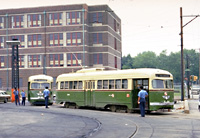 The northeast corner of Luzerne's car yard, at the corner
of 10th and Luzerne Street, included the layover loop for the Route 53 trolley.
Route 53's outer end served affluent West Mt. Airy, and when streamlined PCCs
first arrived in Philadelphia, they were placed in service on this line. Prewar
air cars like the two shown here provided service on this line until they were
finally retired in 1982. Route 53 itself only lasted another four years after
that.
The northeast corner of Luzerne's car yard, at the corner
of 10th and Luzerne Street, included the layover loop for the Route 53 trolley.
Route 53's outer end served affluent West Mt. Airy, and when streamlined PCCs
first arrived in Philadelphia, they were placed in service on this line. Prewar
air cars like the two shown here provided service on this line until they were
finally retired in 1982. Route 53 itself only lasted another four years after
that.
July 8, 1977 photo © Mike Szilagyi
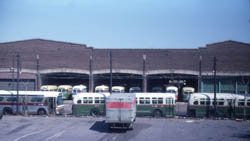 This 1977 photo was taken during a 44-day strike by
TWU Local 234. 7-bay, 8-bay and 9-bay contain idled PCC cars in four paint schemes:
PTC green and cream, Toronto red and cream, and SEPTA Bicentennial red-white-and-blue,
and SEPTA "mini-rehab" orange-white-and-blue.
This 1977 photo was taken during a 44-day strike by
TWU Local 234. 7-bay, 8-bay and 9-bay contain idled PCC cars in four paint schemes:
PTC green and cream, Toronto red and cream, and SEPTA Bicentennial red-white-and-blue,
and SEPTA "mini-rehab" orange-white-and-blue.
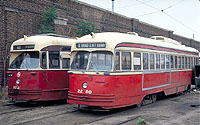 The car yard on the south side of Luzerne Depot was always an interesting place
to poke around. In the late 70s, cars bound for the scrap yard were kept here,
including a number of air cars that looked basically untouched since the 1940s.
All-electrics and Kansas City cars in need of repair were kept here too.
The car yard on the south side of Luzerne Depot was always an interesting place
to poke around. In the late 70s, cars bound for the scrap yard were kept here,
including a number of air cars that looked basically untouched since the 1940s.
All-electrics and Kansas City cars in need of repair were kept here too.
July 13, 1977 photo © Mike Szilagyi
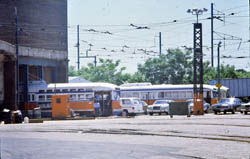 Luzerne Depot's "front" did not face any street.
What would have been 12th Street was never developed on this block.
Luzerne Depot's "front" did not face any street.
What would have been 12th Street was never developed on this block.
When built in 1913, a conveyor belt system for sand occupied the second story
above the doors.
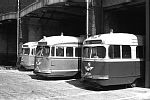
March 1980 photo © Mike Szilagyi
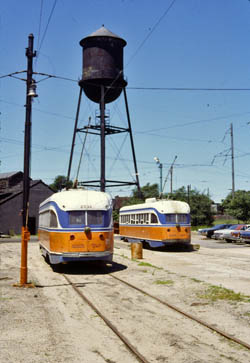 1940 air cars 2535 and 2513 rest in the yard on the
south side of Luzerne Depot.
1940 air cars 2535 and 2513 rest in the yard on the
south side of Luzerne Depot.
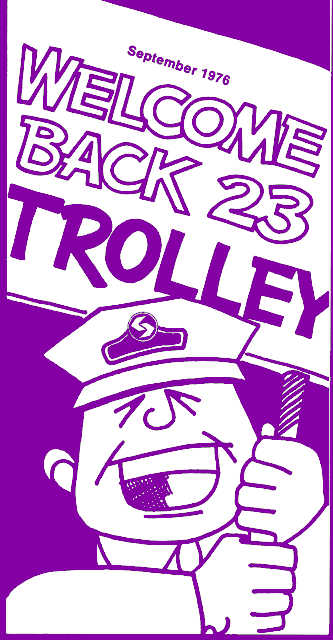 Welcome to Luzerne.
Welcome to Luzerne.
